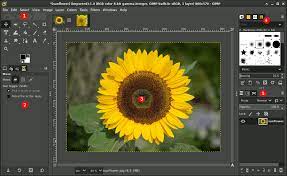GIMP software download for Linux: A Powerful Open-Source Image Editor
GIMP, which stands for GNU Image Manipulation Program, is a highly acclaimed and versatile open-source image editing software available for Linux and other operating systems. It’s a feature-rich alternative to proprietary image editing software like Adobe Photoshop, offering a wide range of tools and capabilities for graphic design, photo retouching, and digital art creation.
Key Features and Benefits:
- Free and Open Source: GIMP is completely free to use, and its open-source nature means it’s continuously improved and maintained by a community of developers worldwide. This makes it accessible to a wide range of users without any licensing fees.
- Cross-Platform: While the primary focus is on Linux, GIMP is also available for Windows and macOS, making it a versatile choice for users who work on multiple platforms.
- Comprehensive Tools: GIMP provides an extensive array of tools for tasks such as image composition, retouching, drawing, and color correction. It supports a wide range of file formats, including popular ones like JPEG, PNG, GIF, and PSD.
- Customizable Interface: GIMP’s interface is highly customizable, allowing users to arrange panels, toolbars, and menus to suit their preferences and workflow. This flexibility enhances productivity and user comfort.
- Layer Support: Like professional image editing software, GIMP supports layers, which enables non-destructive editing and intricate design compositions.
- Advanced Selection and Masking: Users can make precise selections and masks using various techniques, including the intelligent “Scissors Select” tool and the “Paths” tool.
- Plug-ins and Extensions: GIMP’s functionality can be extended through a wide range of plug-ins and extensions, adding new filters, brushes, and effects to enhance creativity.
Downloading GIMP for Linux:
Downloading and installing GIMP on a Linux system is typically straightforward. Most Linux distributions have package managers, such as APT for Debian-based distributions like Ubuntu or YUM for Red Hat-based systems like Fedora, where you can search for and install GIMP. Alternatively, you can download the installer package directly from the GIMP website and follow the installation instructions provided there.
Community and Support:
GIMP benefits from a vibrant and supportive community of users and developers. Online forums, documentation, and tutorials are readily available to help users of all skill levels get the most out of the software. This collaborative ecosystem ensures that GIMP remains a robust and continually evolving image editing tool.
Legal and Ethical Considerations:
It’s important to note that GIMP is a legal and ethical software application, provided under an open-source license. Users are encouraged to adhere to copyright and licensing laws when working with images and other content to ensure ethical and legal use.It’s important to note that GIMP is a legal and ethical software application, provided under an open-source license. Users are encouraged to adhere to copyright and licensing laws when working with images and other content to ensure ethical and legal use.It’s important to note that GIMP is a legal and ethical software application, provided under an open-source license. Users are encouraged to adhere to copyright and licensing laws when working with images and other content to ensure ethical and legal use.It’s important to note that GIMP is a legal and ethical software application, provided under an open-source license. Users are encouraged to adhere to copyright and licensing laws when working with images and other content to ensure ethical and legal use.It’s important to note that GIMP is a legal and ethical software application, provided under an open-source license. Users are encouraged to adhere to copyright and licensing laws when working with images and other content to ensure ethical and legal use.
In summary, GIMP for Linux is a powerful, free, and open-source image editing tool that provides users with a comprehensive set of features for image manipulation, graphic design, and digital art creation. Its cross-platform availability, customizability, and active community support make it a compelling choice for individuals and professionals working on Linux systems.

